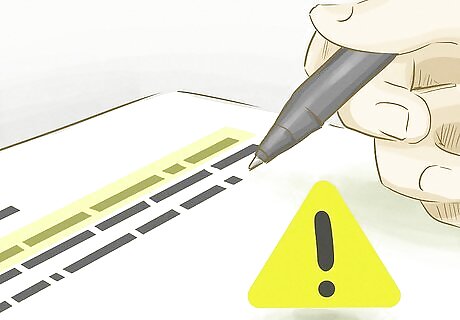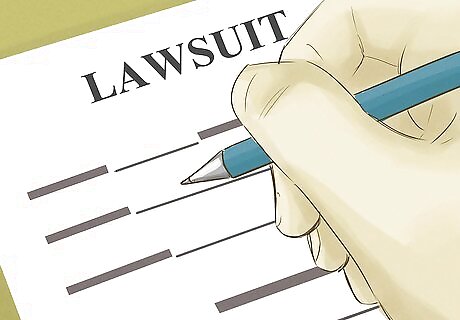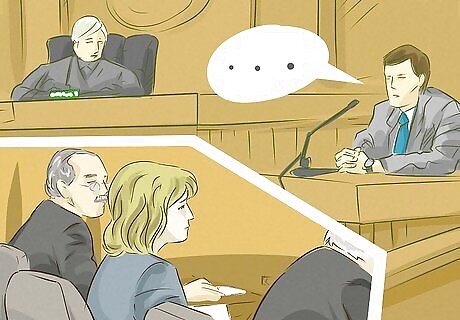
views
How to File for Adverse Possession

Perform a title search. You need to find out exactly who owns the property so that you can sue them in court. You can hire a title company to perform a title search. When you get the title report back, look to see who owns the property. There are many different interests people can have in the property. For example, someone might claim an “easement” on the property. This means that they have the right to use a portion of the property for a certain purpose (e.g., use a driveway to reach their own piece of property). You will need to sue all people who have an interest in the property. This includes the owner, as well as anyone with an easement or other interest. Your title report should identify all of these people.

Consult with a lawyer. Adverse possession claims are complicated. You really have only one shot of winning this kind of lawsuit. Once the owner is tipped off that you are trying to get the property, they will move to eject you. Accordingly, you should think about hiring a lawyer to represent you. He or she can tell you what kinds of evidence will be most persuasive. You can find a lawyer by contacting your local or state bar association and asking for a referral. It helps to be familiar with your s

Format your own complaint if your court does not have a form you can use. You can begin by opening a blank word processing document and setting the font to Times New Roman or Arial 14 point. Also double-space the document and use one-inch margins throughout.

Create a caption. The caption appears at the top of the page. It contains standard information and will not change throughout the lawsuit. The caption should contain the following information: The name of the court. Insert this at the top of the page, centered between the left- and right-hand margins. Also type the court name in bold, all caps. Your name. You are the “plaintiff.” You should type your name like this “Michael Jones, plaintiff.” Put this information beneath the court name, justified with the left-hand margin. The letter “v” a couple of lines below your name. The name of the owner of the property. Space down three lines below the “v” and insert the name of the owner, justified with the left-hand margin. Also add “John Does 1-100” in case there are people you haven’t identified who own an interest in the land. The case number. On the right-hand side of the page, you should type “Case No.” and then leave a blank line. The court clerk will give you a case number when you file your petition.

Title the document. You can title your complaint “Action to Quiet Title” or “Complaint to Quiet Title.” Insert the title right below the caption and make your title all caps, in bold.

Add an introduction. Your introduction can briefly identify yourself and state why you are bringing this action. For example, you could type: “Plaintiff, Michael Jones, representing himself pro se, files this Complaint against the Defendants to Quiet Title with respect to a certain parcel of real estate. In support, Plaintiff states as follows….”

Identify the parties. You should state your name and address. Also include this information for all defendants. Also identify the land. The land is a party to the lawsuit as well. You should state where the property is located, using a street address, but then you should also attach a legal description of the property to the complaint.

Explain that you have adversely possessed the land. Go into detail and explain how you have satisfied your state’s law on adverse possession. You should number your paragraphs so that each fact has its own number. Also be sure to identify your state’s law on adverse possession by number.

Insert a conclusion. In conclusion, request that the court enter judgment in your favor. Then add a signature block underneath the conclusion and include the words “Respectfully submitted” just above the signature line. For example, your conclusion could read: “Wherefore, Plaintiff respectfully requests that this Honorable court find in his favor and against Defendants, and enter a judgment ordering the Recorder of Deeds to convey the property located at [insert address] to Plaintiff, upon presentment of an order stating the same, and granting such other relief as is necessary and appropriate.”

Include a verification. In many states, every complaint must be “verified.” This means that you swear under penalty of perjury that every statement made in the complaint is truthful. You can either create a separate affidavit or you could add a paragraph underneath your signature verifying that the statements are true. For example, you could state the following: “I hereby verify that the statements set forth in the foregoing Complaint are true and correct to the best of my knowledge, information, and belief. I understand that these statements are made subject to the penalties under the laws of Maine relating to unsworn falsification to authorities.”

File with the court. Once you have completed your complaint, you should make multiple copies. Take your copies and the original to the court clerk. Ask to file. You probably will have to pay a filing fee, which will differ depending on your county. If you can’t afford the fee, then ask for a fee waiver form. This form will typically ask for information about your monthly income and expenses.

Serve notice of the lawsuit on the record owner. You will need to give the owner of the property notice that you are suing. Generally, you must arrange for someone to serve a copy of your complaint on the owner. You may also have to publish notice in a newspaper. This publication will let everyone who might claim an interest in the property know that you are trying to quiet title to it.
Going to Court

Organize your evidence. Go through each element that you need to prove to win an adverse possession claim. Then find evidence that can help you prove that you have met the law’s requirements. For example: Hostile occupation. If your state requires that you occupy the land because you have a deed, then get your copy of the deed. It will be an exhibit in your trial. Open and notorious occupation. Use photographs or video that shows you openly possessed the land. You could also find witnesses, such as a neighbor, to testify. Of course, you can testify on your own behalf, but it will be more convincing to also have third party witnesses testify. Continuous possession. You and witnesses can testify that you possessed the land for the required number of years. Payment of taxes. Get receipts that show you made payment.

Dress for success. You should look professional for your trial. Try to dress up as best as you can. Although you don’t have to wear a suit, you should wear one if you feel more comfortable in a suit. Remember the following tips: Men should wear dress pants and with a button-up shirt. Make sure the shirt is long-sleeved (and not short-sleeved). Wear a conservative tie if you have one. For footwear, wear dress shoes (not sneakers) with dark-colored socks. Women can wear a skirt or slacks with a blouse. Women can also wear conservative dresses. For women, fit is most important. Make sure the clothing is not too tight or too revealing. Neither men nor women should wear shorts, blue jeans, tank tops, T-shirts, clothing with writing, flip flops, or hats.

Present your evidence. You will go first at the trial. You should have your witnesses ready to testify. Also have exhibits prepared that support your claim that you have met all of the requirements for adverse possession. For tips on how to question your witnesses, see Question Witnesses when Representing Yourself.

Testify at the trial. You will probably have to testify. For example, you will want to explain to the judge the improvements you have made to the property as well as the fact that you have continuously and exclusively occupied the property for the required number of years. Remember the following tips when you testify: Listen closely to the question and answer the question asked. If you don’t understand a question, ask for clarification. Don’t guess. If you don’t know the answer, then say you don’t know. Always tell the truth. You are testifying under oath, and it is against the law to lie in court. Never argue with the attorney or the judge.

Listen to the defendant’s witnesses. The owner of the property also gets to put on a case. He or she could call witnesses who challenge your version of events. You will have a chance to cross-examine them. For example, the owner might have someone testify that you left the property for long periods of time.

Receive the verdict. The judge should issue a ruling shortly after all evidence has been presented. In many states, you can’t get a jury for a quiet title action, so the judge will hear all of the evidence and then make a decision. If you lose, then you should consider bringing an appeal. An appeal is heard by a higher court, which reviews the trial transcripts. If the judge made a serious error, then the appellate court can set aside the verdict. You can start the appeal process by filing a Notice of Appeal with the trial court. You shouldn’t delay. Generally, you get 30 days or less from the date final judgment is entered to file your Notice of Appeal.

File your judgment with the Recorder of Deeds. In order to become the new record owner of the property, you need to take your final judgment to the Recorder of Deeds office. Ask to enter the judgment on the books so that you show up as the new owner.
Adverse Possession Occupancy Requirements

Occupy the land in a “hostile” fashion. Adverse possession requires that you make a “hostile” claim on the land. This means different things in different states. For example: In some states, simply occupying the land qualifies. Most states follow this rule. In other states, you have to be aware that you are trespassing. This means that you know the land doesn’t belong to you, but you occupy it anyway. In a few states, you must make a good faith mistake when you occupy the land. This generally means that you think you have a valid deed for the property but the deed is either defective or fraudulent.

Possess the land. To adversely claim the property, you must have actual possession. You must also treat it as if you were the owner by, for example, making improvements to the property. Be sure to document any improvements on the property. For example, you might have built a small building on the property or erected a fence. Take photographs of the changes you have made. Evidence like this will be important when you later bring a lawsuit to get title to the property.

Occupy the land in an “open and notorious” fashion. You can’t be hiding on the property if you want to claim it using adverse possession. Instead, it must be obvious to anyone that someone is living on the land. Visible changes to the property should tip people off that someone is living there. Accordingly, take photographs or get witness testimony that they saw you coming and going from the property regularly.

Possess the land continuously and exclusively. To claim adverse possession, you can’t stop into someone’s property once every six months. Instead, the law requires that you really possess it. This means two things: You continuously occupy the land. You can’t abandon the property and then return later. Each state has a time period for how long you must continuously occupy the land. In Massachusetts, for example, you must possess the land for 20 years. In Missouri, by contrast, you must occupy the land for 10 consecutive years. You exclusively occupy the land. You can’t share possession with the actual owner of the property or with strangers.

Pay taxes on the property. In some states, you must actually pay taxes on the land in order to qualify for adverse possession. In other states, the amount of time you must continuously occupy the land will be reduced if you pay taxes. Make sure to hang onto copies of your tax assessment and canceled checks or other proof that shows you paid taxes on the property. For example, in North Dakota, you must continuously occupy the land for 20 years unless you paid property taxes, in which case you must occupy it for only 10 continuous years. You will be sent the tax bill if you took possession with what you thought was a valid deed, and you recorded the deed with the Recorder of Deeds office. However, if you don’t have any deed, then in some counties you can go to the tax assessor’s office and file a document asserting your attempt to establish adverse possession. In Florida, for example, you would file a “Return of Real Property in Attempt to Establish Adverse Possession Without Color of Title.” You can then pay the taxes. Stop in and check with your county tax assessor.




















Comments
0 comment